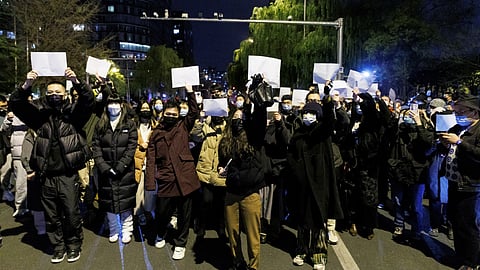

The protests in China over the draconian Zero COVID policy make up a hugely significant moment in the country’s political life. While it is difficult to predict their trajectory, recent events have established a few things. First, that these protests are widespread, occurring in different places in this vast nation, unlike the previous big agitation in Tiananmen Square, which ended after a brutal and repressive massacre. Second, while the COVID restrictions are the trigger, the slogans raised at the protest clearly reflect a disaffection with the Communist Party and its leadership. And finally, they have undermined the authority of President Xi Jinping, who has constantly consolidated his power, and marginalised rivals, since coming to power in 2012.
In the face of this unexpected upsurge, the Chinese government has done something that it is usually extremely reluctant to do – back down. In two trouble-hit cities, Guangzhou and Chongqing, quarantine restrictions have been marginally eased. At the same time, however, Beijing has resorted to the familiar tactic of blaming the protest on “hostile forces” and promising to crack down hard on the protestors. But protests have a way of spreading more quickly in a world with social media; Twitter is already full of videos of protestors calling for Xi Jinping to step down and security personnel in hazmat suits beating up and arresting men and women.
The protests were sparked by a fire that killed 10 in an apartment block in Urumqi, the capital of the troubled Xinjiang province. Apart from spreading with a speed that could not have been anticipated, they have now morphed into something bigger – with agitators demanding democracy, an end to Communist Party rule, and the resignation of Xi Jinping. The Chinese government has patted itself on the back for saving lives thanks to its tough COVID policy; only a little over 5,000 people have died from the coronavirus according to official statistics. Its people – who face mass testing, quarantines, travel restrictions and a slew of other measures – are painfully aware that none of this prevails in other parts of the world, where bars and restaurants are open, sporting events take place, and businesses are running as usual. The huge variance between a suffocating Zero COVID policy and what is being followed elsewhere is not lost on the protestors.
There are no signs yet of any threat to Xi, but if the protests intensify, they can hardly be ignored or dismissed as the handiwork of hostile elements. But China has demonstrated an extraordinary ability to contain protests, often through measures of firm suppression, in the past. And it will be no surprise if this round of anti-Zero COVID policy agitations peter out in a climate where peace and stability are ruthlessly enforced. At the same time, the widespread nature of the protests, which have involved young people and universities, suggest that even if the flame is snuffed out, the embers could well continue to smoulder. What has happened is too big not to have any impact on China’s governance structures at all.
Visit news.dtnext.in to explore our interactive epaper!
Download the DT Next app for more exciting features!
Click here for iOS
Click here for Android